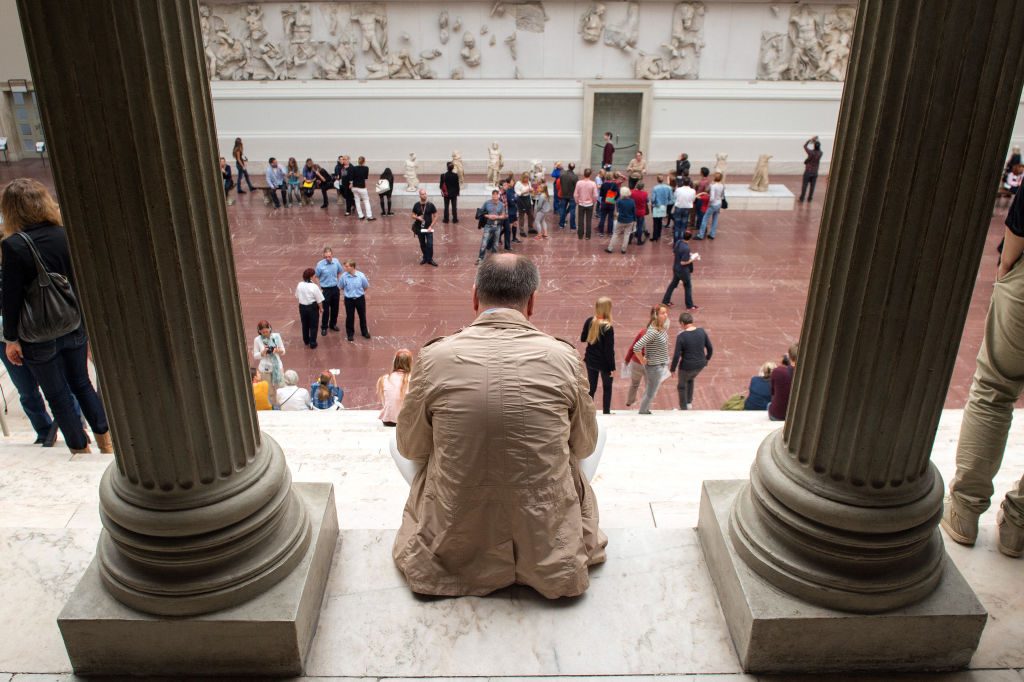In a parallel universe, museum leaders would jet into Abu Dhabi to attend a grand symposium on the future of their industry. But in our present reality, more than 60 museum professionals from the Musée d’Orsay in Paris to the Museum of Black Civilizations in Dakar took part in the Louvre Abu Dhabi and NYU Abu Dhabi’s “Reframing Museums” symposium online.
No museum has been able to escape the impact of the pandemic, from long periods of closure decimating revenues, to the continuous landslide of the exhibitions calendar. But in periods of crisis, there can also be opportunity. One idea that came up repeatedly throughout the symposium was that many of these problems were identified years ago. But now, there is a real urgency to solve them.
Here are three key takeaways for the industry from the discussions.
Museums Need to Find New Revenue Streams. That Might Require Being Nontraditional.
European museums with public support, or those with a mixed model of funding, like in the UK, are faring better than those that depend almost entirely on private funding. As tech entrepreneur Frédéric Jousset pointed out, the pandemic has shown that traditional earned revenue—from events, sponsorships, and ticketing—is not enough to support most institutions through a crisis.
Charge for Content
When museums were first forced to close in the spring, they rushed to make their exhibitions, research, and education offerings available to audiences free online. But that digital investment was expensive, and there is currently no clear business model to support it.
Some proposed adopting a newspaper-industry model to monetize digital content through advertising or a paywall. But the number of small newspapers that have gone under over the past decade suggests that strategy may not be the most sustainable. (London’s National Gallery recently experimented with charging visitors to view an online tour of its Artemisia Gentileschi exhibition, and the decision was met with harsh criticism online.)
Licensing Is the Name of the Game
Jousset pointed out that for large museums with brand cachet, such as the Louvre or the British Museum, there is huge potential in licensing opportunities. Brands are willing to shell out big bucks for these institutions’ worldwide brand awareness and credibility; the automobile company Peugeot-Citroen, for example, paid to shoot the campaign for its up-market DS sedan at the Louvre’s pyramid to market it to a Chinese audience.
Museums can also cash in by licensing works in their collections for products and merchandise (the Vans X Van Gogh Museum collaboration springs to mind). Jousset notes that this approach has been pursued to great effect by the film industry.
Sell Your Expertise…
Museums’ expertise could also become a source of income. Speakers suggested there was potential in monetizing educational activities, such as the online courses at the Museum of Modern Art in New York, where students pay in exchange for a certificate of completion.
Jousset said museums could also monetize their professional know-how by offering consulting services. Statistics show that in the next decade, 5,000 museums and private art centers will open—and many will need to piggy-back on the knowledge of existing institutions.
… Or Loan Out Your Art
Some more taboo ideas were floated as well. The first is the prospect of lending works for money, as the Louvre—which lends some 2,500 artworks a year for free—is starting to do with the Louvre Abu Dhabi. The financial incentive is clear: that partnership alone allowed the Paris museum to build its first-ever endowment fund of €130 million.
Although some museums have pursued similar relationships while their buildings were closed for renovations, Françoise Benhamou, the French economist and professor at the Sorbonne-Paris Nord University, cautioned museums not to forget the ethical principles of openness and accessibility that underpin public institutions.
Whatever You Do, Don’t Sell Out
Benhamou noted that many of Jousset’s suggestions only apply to big museums with established brands. But she offered one suggestion that could be adopted by small and large institutions alike: a tiered-ticketing system in which the wealthiest guests subsidize low-income visitors.
Some museums are already doing this: the Musée d’Orsay offers free tickets to the unemployed, and the Met asks local audiences to pay what they can. But museums may also need to start thinking about increasing prices for different museum experiences, like adopting a surcharge in high tourist seasons.
Museums Need to Expand Whom They Listen to—Fast.
Well before the pandemic, museums were facing calls to address their inherent biases. Those calls became louder and more intent amid the protests following the death of George Floyd and a virus that disproportionately impacted communities of color. Many frontline museum workers who were the first to be furloughed or eliminated are people of color. As Salah Hassan, director of the Africa Institute and a professor at Cornell University, said in one talk: “COVID exposed the afterlife of colonialism.”
Listen Up
Part of the work of dismantling colonialism includes hiring people of color at all levels, consulting with communities outside the museum on programming, and learning to listen to voices from inside the museum that aren’t always heard.
Kaywin Feldman, the director of Washington, D.C.’s National Gallery of Art, defended her museum’s controversial decision to postpone an exhibition of Philip Guston’s work—including paintings depicting the Ku Klux Klan—after she spoke with some of the museum’s security guards, who had a different perspective than the all-white curatorial team.
Know Your Donor
Museums have also faced resounding calls for greater transparency in fundraising, and to distance themselves from patrons (like the Sackler family, ex-Whitney trustee Warren Kanders, and companies like oil giant BP) who could be seen as “artwashing” the unsavory sources of their wealth.
The Met’s director, Max Hollein, said that transparency must be a core foundation of a 21st-century museum, which must be especially responsive to these concerns.
Reconsidering Restitution
When it comes to museum displays that reflect the social mores of another era, such as exhibitions of African heritage that was looted during the colonial period, museums need to work on displaying and contextualizing objects for a 21st-century audience, panelists concluded. In some cases, this includes repatriating heritage to the places it was taken from.
Acquisitions Is One Thing—Context Is Another
As for redressing the historical bias that has largely favored white male artists, Laurence des Cars, the president of the Musée d’Orsay and Musée de l’Orangerie in France, points out that while collections cannot be transformed from scratch, curators can find new ways to display and contextualize them.
Adriano Pedrosa, the artistic director of the Museu de Arte de São Paulo, suggests that beyond acquiring important historical works that were left out of the canon, institutions can bring in contemporary installations to challenge the narrative offered by the historical displays.
If the to-do list seems never-ending, the director general of the Sharjah Museums Authority, Manal Ataya, said that’s because it is: responding to audience concerns is a long-term, ongoing process.
Museums Can’t Take Their Local Audiences for Granted Anymore.
With the high costs of insurance and shipping, museums have been questioning the sustainability of the blockbuster for years. Hervé Barbaret, director general of the cultural consultancy Agence-France Museums, said that postponing these exhibitions during the pandemic has finally forced museums to assess their ultimate value.
Look for the Blockbusters Within
Manuel Borja-Villel, director of the Reina Sofia, noted that with limited travel options for both people and artworks, museums should look to their own collections and domestic resources.
At the same time, he echoed the sentiment of many when he stressed the need to resist becoming too locally minded or nationalistic, especially against the backdrop of the rise of the far-right across Europe, which he says is “a very strong danger” today.
Barbaret added that there is an argument for maintaining touring exhibitions: it is arguably more eco-conscious for an artwork to travel to an audience of 10,000 people, than for even a smaller portion of those viewers to travel to see the work.
The Reframing Museums symposium ran from November 16 through 18. For those who missed it, all of the talks are available to watch online.







